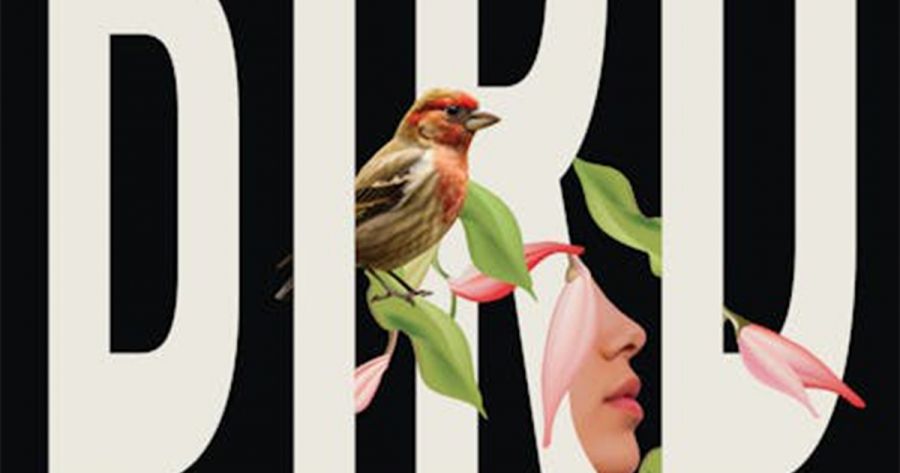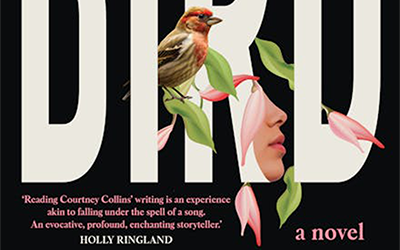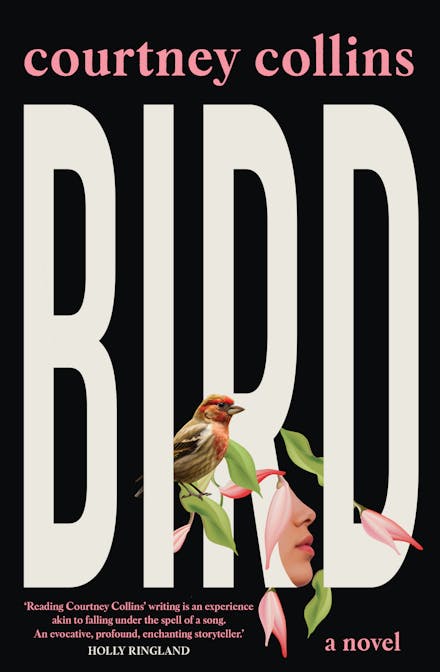
- Free Article: No
- Contents Category: Fiction
- Review Article: Yes
- Article Title: Ineffectual incarnations
- Article Subtitle: Temporarily entangled heroines
- Online Only: No
- Custom Highlight Text:
Stories about women from disparate times and places leading parallel lives are almost a genre unto themselves. In Michael Cunningham’s The Hours, a well-known literary example, Virginia Woolf’s Mrs Dalloway, connects the lives of three twentieth- century women (one of them Woolf herself) in an intergenerational portrait of queerness and mental illness. In Evie Wyld’s The Bass Rock, a trio on the Scottish coast are linked over several centuries through themes of violence against women. In Tracey Chevalier’s The Virgin Blue, an American woman living in France noses out the story of a persecuted ancestor.
- Featured Image (400px * 250px):

- Alt Tag (Featured Image): Laura Elizabeth Woollett reviews ‘Bird’ by Courtney Collins
- Book 1 Title: Bird
- Book 1 Biblio: Hachette, $32.99 pb, 308 pp
- Book 1 Cover Small (400 x 600):

- Book 1 Cover (800 x 1200):

These tales of Temporally Entangled Heroines, while often classifiable as historical fiction, seem to gain commercial appeal from their foothold in the modern world and the momentum of shifting perspectives. Despite varying in scope, style, and quality, Temporally Entangled Heroine narratives can be conceived of as a kind of historical fiction lite: history made explicable through a personalised connection to modernity, and consumable to audiences specifically interested in women’s stories.
Bird, the second novel of Australian author and screenwriter Courtney Collins, is one such narrative, with a spiritual twist. It centres on two fourteen-year-olds named ‘Bird’, both of whom are desperate to spread their wings and fly free. Past Bird (as I shall call her) lives in ‘the Himalayas, Unknown Year’. Present Bird lives in Darwin, but feels the pull of another existence – i.e. her past life in the Himalayas. Present Bird’s sense of presque vu expresses itself as a lifelong urge to draw and paint five girls, whose names she instinctively knows (‘That’s Cleo, Dev, Kai, Reya and Bambi. Bambi’s my favourite,’ she informs her bemused grandmother). Watching the evening news, she glimpses the five girls taking part in a juvenile detention centre riot and resolves to be arrested in order to join them.
If this premise sounds ludicrous, it is. Nonetheless, the question of who the five girls are and how they are connected to the Birds is propulsive. Present Bird’s life is further complicated by her neglectful young mother, Mia, her unknown paternity (‘it could have been an Indian man [Mia] met in Puna or a South American man she met in Nepal,’ she reflects, suggesting a nebulous genetic connection to Past Bird’s homeland), and the threat of sexual assault from Mia’s boyfriend, Jerome. Concurrently, after Past Bird’s father loses her in a bet, she must flee an arranged plural marriage to her brutish brother-in-law, Cho. Both Birds are supported by various sympathetic yet largely ineffectual incarnations and reincarnations, including love interest Teshi, nurse Margie, and Bambi et al. Both are virginal, free-spirited, plucky, and constantly running towards or away from something.
As part of her research for Bird, Collins travelled to the northernmost Indian state of Himachal Pradesh. While Collins’s descriptions of thick butter tea and prostrating pilgrims suggest a level of familiarity (and fascination) with the region, these details do not save the novel from its ahistoricism. Although I am loath to brandish my non-existent PhD in Himalayan Studies, the lack of specificity regarding Past Bird’s origins, the areas she travels through, and the time period that she inhabits seems remiss, given that the Himalayas span 2,400 kilometres across five culturally and linguistically diverse modern-day countries.
Characters bear traditionally Tibetan names (Pema, Lhakyi), vaguely East Asian-sounding names (I could not help but recall the Harry Potter Cho Chang discourse, though it is possible that the male character Cho’s name is derived from the same source as the mountain Cho Oyu), and anachronistic names like Bambi. This, along with Past Bird’s casual use of the word ‘fuck’ and her apathy towards marriage and religion in a society where these forces reign surpreme, create an impression of Ancient Himalayan cosplay rather than fine-grained historical fiction.
Inauthenticity is likewise an issue with the modern-day chapters. Aside from some stray references to watching YouTube and streaming music, Present Bird and her peers are unusually offline 2020s teenagers. They are not anxious about the climate or the economy. Their education and broader development do not appear to have been impacted by Covid-19. As with the imprecision of ‘Himalayas, Unknown Year’, Collins’s inattention to the Zeitgeist has a stultifying effect. Mostly unscathed by the sociopolitical pressures particular to their times, the Birds are oddly interchangeable – equally defined, in past and present, by their bird-like desire for freedom and their vulnerability to predatory men.
It is relatively uncontroversial to insist on the importance of stories about girls and women, especially when these stories feature diverse characters. Were Bird to be adapted for screen, the heroines, their love interests, and many minor characters would likely be played by non-white actors. Present Bird visits a Vietnamese nail salon. Margie hooks up with a Brazilian soccer player. Present Bambi, upon meeting Present Bird, asks, ‘where’s your mob?’ and ‘What’s your Country?’, assuming a shared Aboriginality, and implying that a proportion of the juvenile detention centre residents are Indigenous. The trouble is, Aboriginality is only implied, referenced – never engaged with or contextualised. Diversity, in Bird, is only ever skin-deep. Present Bird, who boasts ‘DNA from every continent on earth, except Antarctica’, is as depoliticised as an AI-generated image of a biracial girl.
Although not all stories featuring non-white protagonists need to focus on experiences of marginalistion (indeed, there are valid criticisms to be made of white authors co-opting stories of racialised trauma), we do not live in a post-racial society. There are differences between being Aboriginal and maybe half-Indian in 2020s Darwin that Collins does not meaningfully interrogate, as she does not seem to appreciate what it means to be from any particular region of the Himalayas at any particular point in history. The past is simply a more exotic version of the present. Girls are always girls, whimsical and intrepid, stronger together, deserving of freedom but not of specificity.


Comments powered by CComment